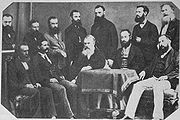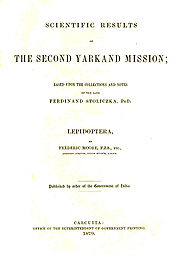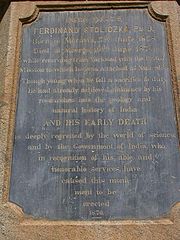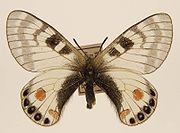
Ferdinand Stoliczka
Encyclopedia
Ferdinand Stoliczka was a Moravia
n palaeontologist who worked in India
on paleontology
, geology
and various aspects of zoology. He died of high altitude sickness during an expedition across the Himalayas.
in Moravia
. Stoliczka, whose father was a forester who took care of the estate of the Archbishop of Olomouc, studied at a German Secondary school in Kromeriz. Although Stoliczka published 79 articles from 1859–1875, he never wrote anything in Czech. It is believed that he spoke German at home. In his Calcutta years he was an important figure in the German-speaking community there.
Stoliczka studied geology
and palaeontology at Prague
and the University of Vienna
under Professor Eduard Suess
and Dr Rudolf Hoernes
. He graduated with a Ph D from the University of Tübingen on 14 November 1861. His early works were studies on some freshwater mollusca
from the Cretaceous rocks of the north-eastern Alps
about which he wrote to the Vienna Academy in 1859. His scientific career proper started in the Austrian Geological Survey, which he joined in 1861, and his first papers there were based on work in the Alps and Hungary.

 In 1862 Stoliczka joined the Geological Survey of India
In 1862 Stoliczka joined the Geological Survey of India
(GSI) under the British Government in India after being recruited by Dr Thomas Oldham
(1816–1878). In Calcutta he was assigned the job of documenting the Cretaceous
fossil
s of southern India and published them in the Palaeontologia indica, along with William Thomas Blanford
. By May 1873 this work was completed with four volumes totalling nearly 1500 quarto size pages with 178 plates. Among these works was the osteological description of Oxyglossus pusillus, a fossil frog from the Deccan Traps
of Bombay.
He studied the geology of the western Himalayas
and Tibet
, and published numerous papers on many subjects including Indian zoology
. He was also briefly (in 1868) the joint curator of the Indian Museum and also the Natural History Secretary of the Asiatic Society of Bengal. He was involved in editing the Society's journal.
. His first Himalayan trip was in 1864 with F. R. Mallet of the GSI. In 1865 he visited again with an artist friend and a dog to the Ladakh Valley. He visited Kutch in 1871–1872 but noted that his geology work kept him from making many observations. He noted wild cheetah
s from the region and also what is now Stoliczka's bushchat. In 1873 he joined an expedition organized by Hume along with Valentine Ball
to the Andaman and Nicobar islands.
ia) was a buffer state of prime importance. The British launched an official diplomatic enterprise—the Second Yarkand Mission led by (afterwards Sir) Douglas Forsyth to Yakub Beg
, the ruler of Chinese Turkestan. The mission had seven sahibs, 350 support staff and 550 animals The expedition needed 6476 porters and 1621 horses and it is said that the Ladakh economy took four years to recover from the losses incurred.
The mission set out from Rawalpindi
to Leh via Murree. The mission travelled past the Pangong Lake
, Changchenmo and Karakash Valley onto Shahidulla and finally to Yarkand. They reached Kashgar in December 1873. On March 17, 1874 they began the return journey. They were to visit the Pamir and Afghanistan areas but could not do so due to the political situation and returned to India via Ladakh. On June 16, 1874 he had severe headaches as they crossed the Karakoram pass (5580 m). That night, he wrote....
 Captain Trotter reported that on the 18th "he started on horseback early in the morning to examine some rocks up the stream." He returned tired and complained of a headache. He breathed heavily and coughed all night. The native doctor diagnosed acute bronchitis and inflammation of the lungs and treated him with brandy mixed in a cough mixture. At 2 p.m. he drank some port wine and "his respiration grew slower and slower, and also did his pulse, and he finally breathed his last, dying so quietly that it was impossible to say at what precise instant he passed away".
Captain Trotter reported that on the 18th "he started on horseback early in the morning to examine some rocks up the stream." He returned tired and complained of a headache. He breathed heavily and coughed all night. The native doctor diagnosed acute bronchitis and inflammation of the lungs and treated him with brandy mixed in a cough mixture. At 2 p.m. he drank some port wine and "his respiration grew slower and slower, and also did his pulse, and he finally breathed his last, dying so quietly that it was impossible to say at what precise instant he passed away".
Stoliczka died on June 19, 1874 at Moorghi in Ladakh
. His dying request was that the birds part of the scientific results of the expedition be published by Allan Octavian Hume
. This work was finally, however completed by Richard Bowdler-Sharpe seventeen years later.
Dr. H. W. Bellew did the post-mortem and confirmed "spinal meningitis deteriorated by over-exertion in strenuous endeavours after information, and the great height." Today this is generally believed to have been Acute Mountain Sickness (AMS), a condition well known to Himalayan travellers. It manifests as pulmonary or cerebral oedema. Above 5000 m this is fatal in about 40% of the cases. Conditions that aggravate it include exertion, fast ascent and alcohol, all of which were present in his case.

, the "father of Indian Ornithology". His first ornithological work was making large collections of birds from the Sutlej Valley.
Arthur Viscount Walden
recognized his contributions and welcomed the geologist Stoliczka to a high place among scientific ornithologists but disagreed with Stoliczka's idea of adding new species due to small differences in plumage. Hume however supported Stoliczka and wrote a note in the journal, Ibis, against the cabinet naturalists of London who knew nothing about the geography of India. Hume shortly afterwards started the journal Stray Feathers and persuaded ornithologists in India to publish there.
Some of Stoliczka's new species were discovered to have been already discovered by the Russian zoologist N. A. Severtzov
. A week before his death, Stoliczka wrote to Valentine Ball
...
 A granite obelisk is erected in his memory at the Moravian mission cemetery in Leh. An obituary was published in Nature, July 9, 1874 by W. T. Blanford
A granite obelisk is erected in his memory at the Moravian mission cemetery in Leh. An obituary was published in Nature, July 9, 1874 by W. T. Blanford
.
A partial list of his publications on birds include

Moravia
Moravia is a historical region in Central Europe in the east of the Czech Republic, and one of the former Czech lands, together with Bohemia and Silesia. It takes its name from the Morava River which rises in the northwest of the region...
n palaeontologist who worked in India
India
India , officially the Republic of India , is a country in South Asia. It is the seventh-largest country by geographical area, the second-most populous country with over 1.2 billion people, and the most populous democracy in the world...
on paleontology
Paleontology
Paleontology "old, ancient", ὄν, ὀντ- "being, creature", and λόγος "speech, thought") is the study of prehistoric life. It includes the study of fossils to determine organisms' evolution and interactions with each other and their environments...
, geology
Geology
Geology is the science comprising the study of solid Earth, the rocks of which it is composed, and the processes by which it evolves. Geology gives insight into the history of the Earth, as it provides the primary evidence for plate tectonics, the evolutionary history of life, and past climates...
and various aspects of zoology. He died of high altitude sickness during an expedition across the Himalayas.
Early life
Stoliczka was born at the lodge Zámeček near KroměřížKromeríž
Kroměříž is a town in the Zlín Region of the Czech Republic. The town's main landmark is the Baroque Kroměříž Bishop's Palace, where some scenes from Amadeus and Immortal Beloved were filmed...
in Moravia
Moravia
Moravia is a historical region in Central Europe in the east of the Czech Republic, and one of the former Czech lands, together with Bohemia and Silesia. It takes its name from the Morava River which rises in the northwest of the region...
. Stoliczka, whose father was a forester who took care of the estate of the Archbishop of Olomouc, studied at a German Secondary school in Kromeriz. Although Stoliczka published 79 articles from 1859–1875, he never wrote anything in Czech. It is believed that he spoke German at home. In his Calcutta years he was an important figure in the German-speaking community there.
Stoliczka studied geology
Geology
Geology is the science comprising the study of solid Earth, the rocks of which it is composed, and the processes by which it evolves. Geology gives insight into the history of the Earth, as it provides the primary evidence for plate tectonics, the evolutionary history of life, and past climates...
and palaeontology at Prague
Prague
Prague is the capital and largest city of the Czech Republic. Situated in the north-west of the country on the Vltava river, the city is home to about 1.3 million people, while its metropolitan area is estimated to have a population of over 2.3 million...
and the University of Vienna
University of Vienna
The University of Vienna is a public university located in Vienna, Austria. It was founded by Duke Rudolph IV in 1365 and is the oldest university in the German-speaking world...
under Professor Eduard Suess
Eduard Suess
Eduard Suess was a geologist who was an expert on the geography of the Alps. He is responsible for hypothesising two major former geographical features, the supercontinent Gondwana and the Tethys Ocean.Born in London to a Jewish Saxon merchant, when he was three his family relocated toPrague,...
and Dr Rudolf Hoernes
Rudolf Hoernes
Rudolf Hoernes was an Austrian geologist, born in Vienna. He studied under Eduard Suess and became a Professor of geology in Graz. He was known for his earthquake studies in 1878 and proposed a classification of earthquakes into subsidence earthquakes, volcanic earthquakes and tectonic earthquakes...
. He graduated with a Ph D from the University of Tübingen on 14 November 1861. His early works were studies on some freshwater mollusca
Mollusca
The Mollusca , common name molluscs or mollusksSpelled mollusks in the USA, see reasons given in Rosenberg's ; for the spelling mollusc see the reasons given by , is a large phylum of invertebrate animals. There are around 85,000 recognized extant species of molluscs. Mollusca is the largest...
from the Cretaceous rocks of the north-eastern Alps
Alps
The Alps is one of the great mountain range systems of Europe, stretching from Austria and Slovenia in the east through Italy, Switzerland, Liechtenstein and Germany to France in the west....
about which he wrote to the Vienna Academy in 1859. His scientific career proper started in the Austrian Geological Survey, which he joined in 1861, and his first papers there were based on work in the Alps and Hungary.
Career in India


Geological Survey of India
Geological Survey of India , established in 1851 is a government organization in India which is an attached office to the Ministry of Mines of Union Government of India for conducting geological surveys and studies. It is one of the oldest of such organizations in the world and the second oldest...
(GSI) under the British Government in India after being recruited by Dr Thomas Oldham
Thomas Oldham
Thomas Oldham was a Anglo-Irish geologist.He was educated at Trinity College, Dublin and studied civil engineering at the University of Edinburgh as well as geology under Robert Jameson....
(1816–1878). In Calcutta he was assigned the job of documenting the Cretaceous
Cretaceous
The Cretaceous , derived from the Latin "creta" , usually abbreviated K for its German translation Kreide , is a geologic period and system from circa to million years ago. In the geologic timescale, the Cretaceous follows the Jurassic period and is followed by the Paleogene period of the...
fossil
Fossil
Fossils are the preserved remains or traces of animals , plants, and other organisms from the remote past...
s of southern India and published them in the Palaeontologia indica, along with William Thomas Blanford
William Thomas Blanford
William Thomas Blanford was an English geologist and naturalist. He is best remembered as the editor of a major series on The Fauna of British India, Including Ceylon and Burma.-Biography:Blanford was born in London...
. By May 1873 this work was completed with four volumes totalling nearly 1500 quarto size pages with 178 plates. Among these works was the osteological description of Oxyglossus pusillus, a fossil frog from the Deccan Traps
Deccan Traps
The Deccan Traps are a large igneous province located on the Deccan Plateau of west-central India and one of the largest volcanic features on Earth. They consist of multiple layers of solidified flood basalt that together are more than thick and cover an area of and a volume of...
of Bombay.
He studied the geology of the western Himalayas
Himalayas
The Himalaya Range or Himalaya Mountains Sanskrit: Devanagari: हिमालय, literally "abode of snow"), usually called the Himalayas or Himalaya for short, is a mountain range in Asia, separating the Indian subcontinent from the Tibetan Plateau...
and Tibet
Tibet
Tibet is a plateau region in Asia, north-east of the Himalayas. It is the traditional homeland of the Tibetan people as well as some other ethnic groups such as Monpas, Qiang, and Lhobas, and is now also inhabited by considerable numbers of Han and Hui people...
, and published numerous papers on many subjects including Indian zoology
Zoology
Zoology |zoölogy]]), is the branch of biology that relates to the animal kingdom, including the structure, embryology, evolution, classification, habits, and distribution of all animals, both living and extinct...
. He was also briefly (in 1868) the joint curator of the Indian Museum and also the Natural History Secretary of the Asiatic Society of Bengal. He was involved in editing the Society's journal.
Expeditions
He visited Burma, Malaysia and Singapore, and made two trips to the Andaman and Nicobar Islands and the Rann of KutchRann of Kutch
The Great Rann of Kutch, also called Greater Rann of Kutch or just Rann of Kutch , is a seasonal salt marsh located in the Thar Desert in the Kutch District of Gujarat, India and the Sindh province of Pakistan....
. His first Himalayan trip was in 1864 with F. R. Mallet of the GSI. In 1865 he visited again with an artist friend and a dog to the Ladakh Valley. He visited Kutch in 1871–1872 but noted that his geology work kept him from making many observations. He noted wild cheetah
Cheetah
The cheetah is a large-sized feline inhabiting most of Africa and parts of the Middle East. The cheetah is the only extant member of the genus Acinonyx, most notable for modifications in the species' paws...
s from the region and also what is now Stoliczka's bushchat. In 1873 he joined an expedition organized by Hume along with Valentine Ball
Valentine Ball
Valentine Ball was an Irish geologist, and a brother of Sir Robert Ball.Ball joined the Geological Survey of India, becoming an authority not only on geology but also on ornithology and anthropology. His best known work is Jungle-Life in India...
to the Andaman and Nicobar islands.
Last expedition
His third and last expedition was the most important expedition (1873–1874) during the height of the "Great Game", the rivalry between the Russian and British empires. Eastern Turkestan (KashgarKashgar
Kashgar or Kashi is an oasis city with approximately 350,000 residents in the western part of the Xinjiang Uyghur Autonomous Region of the People's Republic of China. Kashgar is the administrative centre of Kashgar Prefecture which has an area of 162,000 km² and a population of approximately...
ia) was a buffer state of prime importance. The British launched an official diplomatic enterprise—the Second Yarkand Mission led by (afterwards Sir) Douglas Forsyth to Yakub Beg
Yakub Beg
Muhammad Yaqub Bek was a [Turkic peoples] adventurer who became head of the kingdom of Kashgaria.-Spelling variants:In English-language literature, the name of Yaqub Beg has also been spelt as Yakub Beg , Yakoob Beg , or Ya`qūb Beg...
, the ruler of Chinese Turkestan. The mission had seven sahibs, 350 support staff and 550 animals The expedition needed 6476 porters and 1621 horses and it is said that the Ladakh economy took four years to recover from the losses incurred.
The mission set out from Rawalpindi
Rawalpindi
Rawalpindi , locally known as Pindi, is a city in the Pothohar region of Pakistan near Pakistan's capital city of Islamabad, in the province of Punjab. Rawalpindi is the fourth largest city in Pakistan after Karachi, Lahore and Faisalabad...
to Leh via Murree. The mission travelled past the Pangong Lake
Pangong Tso
Pangong Tso is an endorheic lake in the Himalayas situated at a height of about . It is long and extends from India to Tibet. 60% of the length of the lake lies in China. The lake is wide at its broadest point...
, Changchenmo and Karakash Valley onto Shahidulla and finally to Yarkand. They reached Kashgar in December 1873. On March 17, 1874 they began the return journey. They were to visit the Pamir and Afghanistan areas but could not do so due to the political situation and returned to India via Ladakh. On June 16, 1874 he had severe headaches as they crossed the Karakoram pass (5580 m). That night, he wrote....
- ...upon this followed massive dolomitic limestone and this was overlain with blue shales. I must have a ramble in these limestones tomorrow.

Stoliczka died on June 19, 1874 at Moorghi in Ladakh
Ladakh
Ladakh is a region of Jammu and Kashmir, the northernmost state of the Republic of India. It lies between the Kunlun mountain range in the north and the main Great Himalayas to the south, inhabited by people of Indo-Aryan and Tibetan descent...
. His dying request was that the birds part of the scientific results of the expedition be published by Allan Octavian Hume
Allan Octavian Hume
Allan Octavian Hume was a civil servant, political reformer and amateur ornithologist in British India. He was one of the founders of the Indian National Congress, a political party that was later to lead the Indian independence movement...
. This work was finally, however completed by Richard Bowdler-Sharpe seventeen years later.
Dr. H. W. Bellew did the post-mortem and confirmed "spinal meningitis deteriorated by over-exertion in strenuous endeavours after information, and the great height." Today this is generally believed to have been Acute Mountain Sickness (AMS), a condition well known to Himalayan travellers. It manifests as pulmonary or cerebral oedema. Above 5000 m this is fatal in about 40% of the cases. Conditions that aggravate it include exertion, fast ascent and alcohol, all of which were present in his case.

Ornithological contributions
Stoliczka's interest in birds started only in 1864 when in the Himalayas and he was greatly encouraged by Allan Octavian HumeAllan Octavian Hume
Allan Octavian Hume was a civil servant, political reformer and amateur ornithologist in British India. He was one of the founders of the Indian National Congress, a political party that was later to lead the Indian independence movement...
, the "father of Indian Ornithology". His first ornithological work was making large collections of birds from the Sutlej Valley.
Arthur Viscount Walden
Arthur Hay, 9th Marquess of Tweeddale
Colonel Arthur Hay, 9th Marquess of Tweeddale , known before 1862 as Lord Arthur Hay and between 1862 and 1876 as Viscount Walden, was a Scottish soldier and ornithologist. He was born at Yester, Gifford, East Lothian. He served as a soldier in India and the Crimea. He succeeded his father to the...
recognized his contributions and welcomed the geologist Stoliczka to a high place among scientific ornithologists but disagreed with Stoliczka's idea of adding new species due to small differences in plumage. Hume however supported Stoliczka and wrote a note in the journal, Ibis, against the cabinet naturalists of London who knew nothing about the geography of India. Hume shortly afterwards started the journal Stray Feathers and persuaded ornithologists in India to publish there.
Some of Stoliczka's new species were discovered to have been already discovered by the Russian zoologist N. A. Severtzov
Nikolai Alekseevich Severtzov
Nikolai Alekseevich Severtzov was a Russian explorer and naturalist.On an expedition to the Syr Darya he was captured by bandits and freed after a month. In 1865-68 he explored the Tien Shan and Lake Issyk Kul...
. A week before his death, Stoliczka wrote to Valentine Ball
Valentine Ball
Valentine Ball was an Irish geologist, and a brother of Sir Robert Ball.Ball joined the Geological Survey of India, becoming an authority not only on geology but also on ornithology and anthropology. His best known work is Jungle-Life in India...
...
- 'Please tell Waterhouse to order for the Asiatic, Severtzov's Turkestanskie Jevotnie immediately, if it is not at the Indian Museum. If they do not like ordering it, order it for myself through Truebner without delay. Do not forget, please.'

William Thomas Blanford
William Thomas Blanford was an English geologist and naturalist. He is best remembered as the editor of a major series on The Fauna of British India, Including Ceylon and Burma.-Biography:Blanford was born in London...
.
A partial list of his publications on birds include
- Stoliczka, F. (1873): Letters to the Editor. Stray Feathers. 1(5):425-427.
- Stoliczka, F. (1874): Letters to the Editor. Stray Feathers. 2(4&5):461-463.
- Stoliczka, F. (1874): Letters to the Editor. Stray Feathers. 2(4&5):463-465.
- Stoliczka, F. (1875): The avifauna of Kashgar in winter. Stray Feathers. 3(1,2&3):215-220.
- Stoliczka, F. (1872): Notice of the mammals and birds inhabiting Kachh [Cutch]. Jour. Asiatic Soc. Bengal 41(2):211-258.
- Stoliczka, F. (1868): Ornithological observations in the Sutlej valley, N.W. Himalayas. Jour. Asiatic Soc. Bengal 37(2):1-70.
Eponymous species
Some of the species named after him are listed below. Not all names may be currently valid.
- The snake genus Stoliczkaia
- Ladakh Banded ApolloParnassius stoliczkanusLadakh Banded Apollo Parnassius stoliczkanus is a rare high-altitude butterfly which is found in Central Asia. It is a member of the Snow Apollo genus Parnassius of the Swallowtail family. It is named after the naturalist and explorer Ferdinand Stoliczka.-Description:Male upperside dull white...
, Parnassius stoliczkanusParnassius stoliczkanusLadakh Banded Apollo Parnassius stoliczkanus is a rare high-altitude butterfly which is found in Central Asia. It is a member of the Snow Apollo genus Parnassius of the Swallowtail family. It is named after the naturalist and explorer Ferdinand Stoliczka.-Description:Male upperside dull white...
C. & R. Felder 1864 - Orange Clouded Yellow, Colias stoliczkana
- Stoliczka's crab spider (Thomisus stoliczka)
- Stoliczka's Tic-Tac-Toe Barb (Puntius stoliczkanusPuntius stoliczkanusStoliczkae's Barb is a freshwater tropical fish belonging to the minnow family . It is a native of the upper Mekong, Salwen, Irrawaddy, Meklong and upper Charo Phraya basins in the countries of Nepal, India, Pakistan, Myanmar, Bangladesh, Laos, Thailand, and Sri Lanka.Puntius stoliczkanus is ...
) / (Barbus stoliczkanus) - Stoliczka's Loach (Nemacheilus stoliczkai)
- Stoliczka's BushchatStoliczka's BushchatThe White-browed Bush Chat ,Saxicola is masculine leading to the species epithet ending in -us also known as Stoliczka's Bushchat, is an Old World flycatcher in the genus Saxicola...
(Saxicola macrorhyncha) - Stoliczka's Treecreeper (Certhia nipalensis)
- Stoliczka's Trident Bat (Aselliscus stoliczkanus)
- Stoliczka's mountain vole (Alticola stoliczkanus)
- Mongolian rock agama (Laudakia stoliczkana)
Other sources
- Kolmas, Josef (1982) Ferdinand Stoliczka (1838–1874) the life and work of the Czech explorer in India and high Asia. Arbeitskreis Fur Tibetische und Buddhistische Studien Universitat Wien (Vienna)

